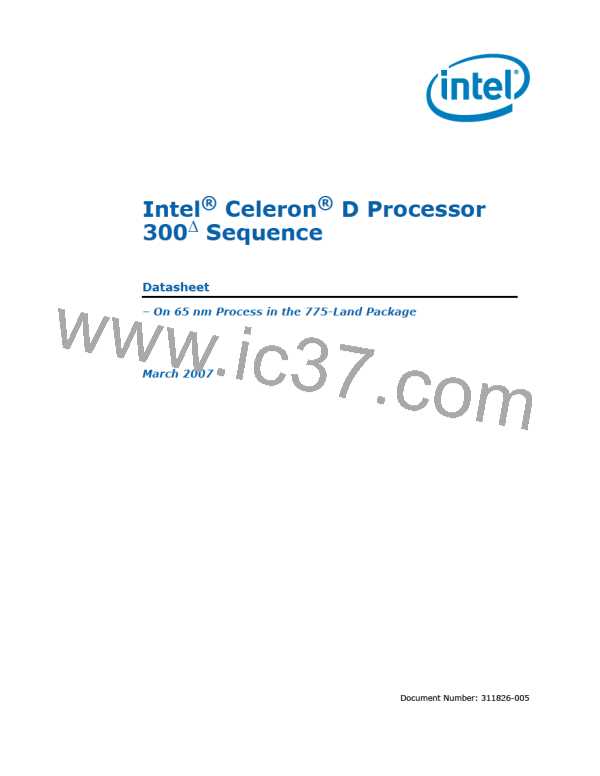Thermal Specifications and Design Considerations
5.2.3
PROCHOT# Signal
An external signal, PROCHOT# (processor hot), is asserted when the processor die
temperature has reached its maximum operating temperature. If the Thermal Monitor
is enabled (note that the Thermal Monitor must be enabled for the processor to be
operating within specification), the TCC will be active when PROCHOT# is asserted. The
processor can be configured to generate an interrupt upon the assertion or de-
assertion of PROCHOT#. Refer to the Intel Architecture Software Developer's Manuals
for specific register and programming details.
The Celeron D processor implements a bi-directional PROCHOT# capability to allow
system designs to protect various components from over-temperature situations. The
PROCHOT# signal is bi-directional in that it can either signal when the processor has
reached its maximum operating temperature or be driven from an external source to
activate the TCC. The ability to activate the TCC via PROCHOT# can provide a means
for thermal protection of system components.
One application is the thermal protection of voltage regulators (VR). System designers
can create a circuit to monitor the VR temperature and activate the TCC when the
temperature limit of the VR is reached. By asserting PROCHOT# (pulled-low) and
activating the TCC, the VR can cool down as a result of reduced processor power
consumption. Bi-directional PROCHOT# can allow VR thermal designs to target
maximum sustained current instead of maximum current. Systems should still provide
proper cooling for the VR, and rely on bi-directional PROCHOT# only as a backup in
case of system cooling failure. Refer to the Voltage Regulator-Down (VRD) 10.1 Design
Guide For Desktop and Transportable LGA775 Socket for details on implementing the
bi-directional PROCHOT# feature.
5.2.4
5.2.5
THERMTRIP# Signal
Regardless of whether or not Thermal Monitor is enabled, in the event of a catastrophic
cooling failure, the processor will automatically shut down when the silicon has reached
an elevated temperature (refer to the THERMTRIP# definition in Table 25). At this
point, the FSB signal THERMTRIP# will go active and stay active as described in
Table 25. THERMTRIP# activation is independent of processor activity and does not
generate any bus cycles.
T
and Fan Speed Reduction
CONTROL
TCONTROL is a temperature specification based on a temperature reading from the
thermal diode. The value for TCONTROL will be calibrated in manufacturing and
configured for each processor. When TDIODE is above TCONTROL then TC must be at or
below TC_MAX as defined by the thermal profile in Table 28; otherwise, the processor
temperature can be maintained at TCONTROL (or lower) as measured by the thermal
diode.
The purpose of this feature is to support acoustic optimization through fan speed
control. Contact your field representative for further details.
5.2.6
Thermal Diode
The processor incorporates an on-die PNP transistor whose base emitter junction is
used as a thermal "diode", with its collector shorted to Ground. A thermal sensor
located on the system board may monitor the die temperature of the processor for
thermal management and fan speed control. Table 30, Table 31, Table 32, and Table 33
provide the "diode" parameter and interface specifications. Two different sets of "diode"
parameters are listed in Table 30 and 31. The Diode Model parameters (Table 30) apply
to traditional thermal sensors that use the Diode Equation to determine the processor
Datasheet
81

 INTEL [ INTEL ]
INTEL [ INTEL ]